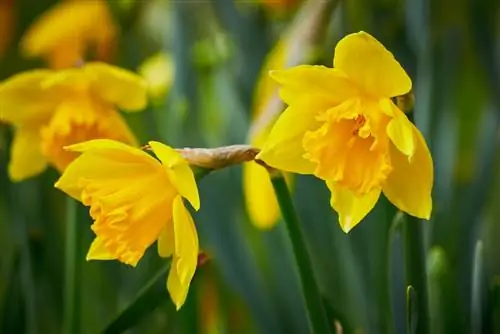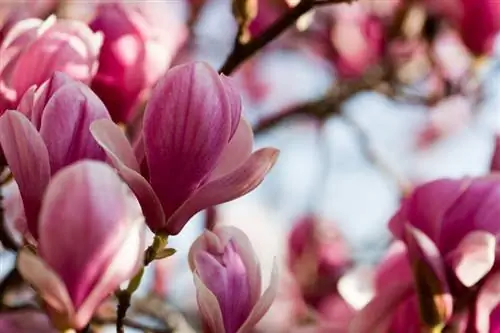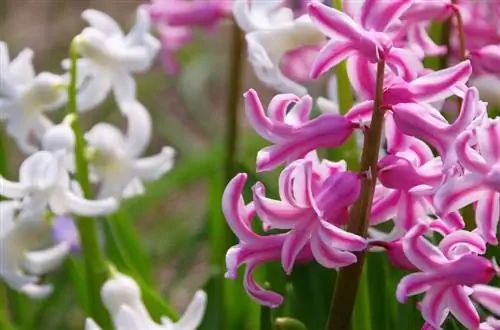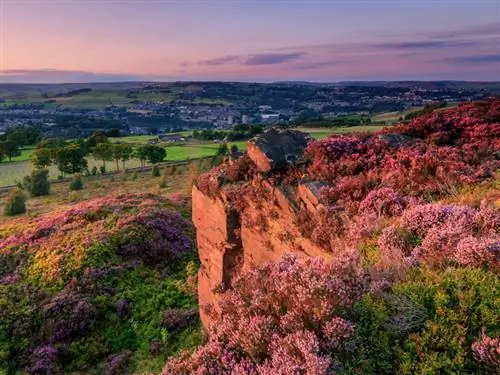- Author admin [email protected].
- Public 2023-12-16 16:46.
- Last modified 2025-06-01 06:02.
Read the commented daffodil profile here for useful information about growth, flowers, leaves and toxicity. Many tips explain how to plant and care for the yellow daffodil correctly.

What are the characteristics of a daffodil?
The daffodil (Narcissus pseudonarcissus) is a yellow-flowering spring flower from the amaryllis family. It has trumpet-shaped individual flowers, lanceolate leaves and grows to a height of 15 to 40 cm. Daffodils are hardy, long-lasting, easy to care for and very poisonous.
Profile
- Scientific name: Narcissus pseudonarcissus
- Family: Amaryllis family (Amaryllidaceae)
- Synonyms: yellow daffodil, daffodil, trumpet daffodil
- Occurrence: Western Europe
- Growth type: Perennial
- Growth height: 15 cm to 40 cm
- Flower: single flower, trumpet
- Leaf: lanceolate
- Root: Onion
- Fruit: Capsule
- Toxicity: very poisonous
- Use: flower bed, potted garden, cut flower
Growth
The daffodil is an early bloomer with cult status. The most important plant species within the daffodil genus (Narcissus) is also called the yellow daffodil because it heralds spring with bright yellow flowers. The flower of the year 1981 is native to western Central Europe, where it primarily inhabits moist meadows and secluded forest clearings. Wild occurrences are very rare and are subject to strict nature conservation. Large-flowered garden forms transform front gardens and parks into a sea of yellow flowers every year at Easter. The high appreciation of daffodils is based on these growth characteristics:
- Growth type: perennial, herbaceous flowering plant (perennial).
- Growth habit: basal leaves from which rises a tightly upright, stable, two-edged stem with a terminal, trumpet-shaped single flower.
- Growth height: 15 cm to 40 cm.
- Root: Onion with a corky base plate from which suction and pulling roots up to 30 cm long arise.
- Ghorticulturally interesting properties: hardy, long-lasting, stable, easy to care for, tolerates cutting, poisonous, spreads easily through daughter bulbs.
Interesting detail about the naming: The generic name is also a term in psychology. Narcissism describes a personality disorder that is characterized by extreme self-absorption. Greek mythology tells of Narcissus, a young handsome man who fell in love with his own reflection and died because of this unfulfillable love. At the site of his death there was no body found, but a yellow flower called a daffodil.
Video: Daffodils - yellow signs of spring in the garden
Bloom
Flowers with these characteristics determine the appearance of a daffodil:
- Flowering time: March and April.
- Flower shape: bell-shaped to star-shaped main crown, trumpet-like, longitudinally wrinkled secondary crown with ruffled or lobed edge, 6 stamens.
- Flower color: bright yellow main crown, yolk yellow secondary crown.
- Special feature: the secondary crown can change its color during the flowering period to light yellow, white or orange.
- flower ecology: hermaphrodite
- Position: terminal, nodding.
- Pollinators: bees, bumblebees, butterflies and other insects.
The secondary crown was formed in the course of evolution from former stamens that grew into a tubular structure. In the period that followed, today's six stamens and the pistil with its three-spiked style developed. With this flower modification, the ingenious daffodil aimed to optimize its attraction to potential pollinators. Despite the low supply of nectar and pollen, the yellow daffodil is a valuable pasture for bees due to its early flowering period.
Leaf
The angular stem with its decorative trumpet flower is surrounded by basal leaves with these identifying features:
- Leaf shape: upright, linear to lanceolate, blunt at the top of the leaf.
- Leaf length: 10 cm to 25 cm; sometimes just as long as the stem.
- Leaf color: green
- Special feature: the leaves of a daffodil wilt about 6 weeks after flowering.
Worth knowing for hobby gardeners: The ability of a daffodil to bloom can be determined by the number of leaves it has. A strong-flowering yellow daffodil has four to six leaves. Two to three leaves thrive on young daffodils that are not yet ready to bloom.
Toxicity
All parts of a daffodil plant are highly poisonous. When larger quantities are consumed, the toxins they contain cause severe symptoms of poisoning, such as nausea and vomiting, symptoms of paralysis, circulatory collapse and cardiac arrest. Unprotected skin contact with the toxic plant sap causes painful skin irritations. This contact allergy, common among gardeners, is also known as daffodil dermatitis. The highest concentration of toxins is found in the bulbs, as is typical for most amaryllis plants.
Fruit
Capsular fruits with three chambers develop from pollinated daffodil flowers. There are numerous black seeds in each chamber. After a ripening period of five to six weeks, the back seams of the capsules tear open and release the seeds. In this phase, a gust of wind or a passing animal is enough for the seed to fall out of its chamber. The seeds of a daffodil are dark and cold germinators.
Planting daffodils
The best time to plant daffodil bulbs is from September to November. Good soil preparation at a suitable location and expert planting at a perfect planting depth set the stage for a yellow flower fairytale in spring. You can find out where and how to plant daffodils correctly here:
Location
These are the ideal location conditions for planting daffodils:
- Sun to partial shade.
- Normal garden soil, ideally nutrient-rich, loose and permeable, with a pH value of 6.5 to 7.
- Top location: on the edge of deciduous trees, fresh and moist in spring and autumn, dry in summer.
Planting - Tips & Tricks
How deep do the bulbs of a daffodil go into the ground? Which planting distance is correct? What to do if the soil does not meet ideal conditions? The following planting tips provide a compact answer to these and other important questions:
- Mandatory: put on gloves before starting planting work.
- Reference planting depth: twice to three times the height of a daffodil bulb.
- Drainage (recommended): Cover the bottom of the planting hole with expanded clay, lava mulch or grit; Spread some sand over it.
- Starting fertilization: enrich the excavation of the planting pit with horn shavings or sifted compost soil in a ratio of 3:1.
- Loamy soil: mix one third with sand to improve water drainage without waterlogging.
- Planting distance: 15-20 cm for tall varieties, 8-12 cm for dwarf varieties.
- Planting technique: Plant the flower bulb with the pointed side facing up, fill the planting hole with soil, press down and water.
- Extra tip: Mark planting locations with a wooden stick.
Daffodils look best when you plant the bulbs in groups.
Excursus
Daffodil daffodil difference
Daffodil and daffodil can be distinguished according to this basic botanical rule: Every daffodil is a daffodil - not every daffodil is automatically a daffodil. Explanation: Daffodils (Narcissus) form a species-rich genus of plants, the best-known subspecies of which is the daffodil. Because a real daffodil always has yellow trumpet flowers, the flower is also aptly called the yellow daffodil. Other types of daffodils delight with variable flower shapes and bloom not only yellow, but also white, orange, red, pink or two-tone.
Care for Easter bells
The daffodil is easy to care for and can remain in the same location in the ground for years. A yellow daffodil is watered and fertilized in accordance with the flowering period. Cutting in stages promotes vital growth and directs the plant's energy towards exuberant flowering. The easiest way to propagate vegetatively is through breeding onions. Under certain conditions, light winter protection makes sense. The best care tips for telegram style daffodils:
Don’t forget gloves
Before you start caring for a daffodil, please put on gloves. If the toxic plant sap comes into contact with your skin, there is a risk of excruciating itching, painful swelling and other allergic reactions caused by narcissus dermatitis.
Pouring
- Keep Easter bells evenly moist before and during flowering without waterlogging.
- Water after flowering in summer when the soil is noticeably dry.
- Water the Easter bells in the pot and balcony box regularly after a finger test.
- Preferably use stale tap water, pond water or rainwater as irrigation water.
Fertilize
- Fertilize daffodils in the bed before and after flowering with compost, guano or horn shavings.
- Fertilize balcony plants every two weeks from March to May with a liquid fertilizer for flowering plants.
Cutting
Two aspects worth knowing about proper pruning care: Once daffodils have faded, remaining nutrients from the leaves are transferred to the bulbs as a nutrient depot for the next year. The daffodil invests a large proportion of its energy reserves in the long ripening period of fruits and seeds, which are then no longer available for the formation of daughter bulbs. This is how you cut Easter bells in an exemplary manner:
- Cut off wilted flowers as soon as possible.
- Leave the leaves and stems for now.
- In summer, cut back completely dead plant parts to the ground level.
Propagate
The mother bulb of a daffodil forms one or more daughter bulbs. These breeding bulbs are ideal for simple, vegetative propagation. How to do it right:
- Dig up the daffodil after cutting it back to the ground.
- Cut the daughter onions with a sharp, disinfected knife.
- Important: Cut off the daughter bulbs so that they contain a piece of the base plate as a starting point for the suction roots.
- Dust cuts with charcoal powder or rock dust.
- Replant the mother onion at its previous location.
- Put the daughter onions in a new place or in a pot.
- Extra tip: By summering the bulbs of a daffodil above ground like tulip bulbs, you prevent unwanted, premature sprouting.
This procedure is recommended every three to four years as a rejuvenation treatment so that the yellow daffodil does not become lazy.
Wintering
In the planting year and in pot culture, the daffodil benefits from light winter protection. This is how it works:
- Mulch the planting site in the bed with autumn leaves and spruce branches, compost soil or a coconut disc.
- In regions with mild winters, place the pot and box on wood, cover it with fleece, and protect it from wind and rain.
- In rough locations, ideally place plant pots in a frost-free, cool and dark winter quarters.
Diseases and pests
Easter bells are susceptible to various diseases and pests. Over the years, early bloomers can suffer from exhaustion. The following table summarizes common malfunctions and their causes as well as tips for countermeasures:
| malicious image | Cause | Countermeasure |
|---|---|---|
| Soft stems, stunted leaves | Blight (Phytophthora infestans) | dig up, destroy |
| Gray mushroom lawn, brown spots | Grey mold (Botrytis cinerea) | cut off and burn infected plant parts |
| Yellow leaves in the midst of flowering | Onion basal rot (Fusarium oxysporum) | clear, destroy |
| Stunted shoot, hollowed out bulb | Daffodil fly (Merodon equestris) | dig up, destroy |
| Young onion with maggot infestation | Daffodil fly (Merodon equestris) | Put onion in warm water at 42°-43° Celsius |
| Pitting on the leaves, buds do not open | Lily chick (Lilioceris lilii) | shower, spray soap-spirit solution |
| Eaten flowers | Snails | Pick up barrier, coffee grounds, snails |
| Sparse flowers | floral exhaustion | dividing and transplanting |
Popular varieties
The daffodil played a key role as a parent in these beautiful yellow daffodil varieties:
- Arctic Gold: Ideal image of a well-formed trumpet daffodil with golden yellow flowers on sturdy stems, beautiful cut flower, growth height up to 35 cm.
- Butterfly Daffodil: bright yellow petals on the outside, corolla with slotted, orange petals on the inside, flowering period April to May, height up to 35 cm.
- Tenby daffodil (Narcissus pseudonarcissus ssp. obvallaris): historic daffodil, bright yellow trumpet flowers, height 20-30 cm.
- Jonquilla Narcissus: Accidental find from 1886 in Portugal with pure golden-yellow trumpet flowers in pairs on slender stems, the most beautiful daffodil for the rock garden, height 20-25 cm.
- Tete a Tete: most popular dwarf daffodil, multi-flowered (2-3 flowers per stem), ideal for pots and flower boxes, height 10 cm to 15 cm.
FAQ
What is another name for the daffodil?
The daffodil is also called Easter bell due to the proximity of its flowering time to Easter. Other names for the early bloomer include yellow narcissus, trumpet narcissus and false narcissus. The botanical name is Narcissus pseudonarcissus because the daffodil belongs to the genus of daffodils.
What is the visible difference between daffodils and daffodils?
You have to look closely to distinguish daffodils and daffodils. The daffodil is a species of plant in the daffodil genus with bright yellow trumpet flowers in March and April. Linear leaves with blunt leaf ends are gathered around the upright, angular flower stalk. There are also 60 to 85 other species of daffodils with lanceolate, strap-shaped or grass-like leaves, variable flower shapes, a variety of flower colors and a flowering period between April and June.
Are daffodils poisonous?
Yes, daffodils are very poisonous in all parts of the plant. Like all plant species from the amaryllis family (Amaryllidaceae), a daffodil is full of toxins. The poison control center at the University Hospital in Bonn names the most important toxins as the alkaloids lycorine, galanthamine, haemanthamine as well as calcium oxalates and a previously unexplored bitter substance. The highest concentration of poison is in the onion. Severe or fatal poisoning usually occurs when daffodil bulbs are confused with kitchen onions. Experts warn that even daffodil flower water is poisonous.
When should you plant daffodils?
The best time to plant daffodils is in autumn. If the bulbs are planted in the ground between September and November, the first roots will form in time for winter. If you miss this ideal date, plant daffodils in spring as soon as the ground has thawed.
Which daffodil varieties are suitable for naturalizing in the lawn?
First choice for naturalization in the lawn are wild and small daffodils, such as Narcissus pseudonarcissus and Narcissus jonquilla var. henriquesii. The varieties 'Dutch Master', 'Golden Harvest', 'Carlton' and 'February Gold' have also proven to be excellent. In order for yellow daffodils to successfully grow wild in a lawn, please wait until all flowers and leaves have completely withered before cutting the lawn.
Withered daffodils leave gaps in the perennial bed. What to do?
As early bloomers, daffodils are only a shadow of their former self when the main season begins in the perennial bed. With suitable plant neighbors, you can hide the gaps after cutting back the withered flowers and curled leaves. Daylilies (Hemerocallis) are highly recommended for this purpose. While daffodils are blooming, daylilies begin to sprout their leaves. The flowering period starts in early/mid June. Beautiful varieties such as the lemon daylily (Hemerocallis citrina) seamlessly continue the yellow flower festival.






